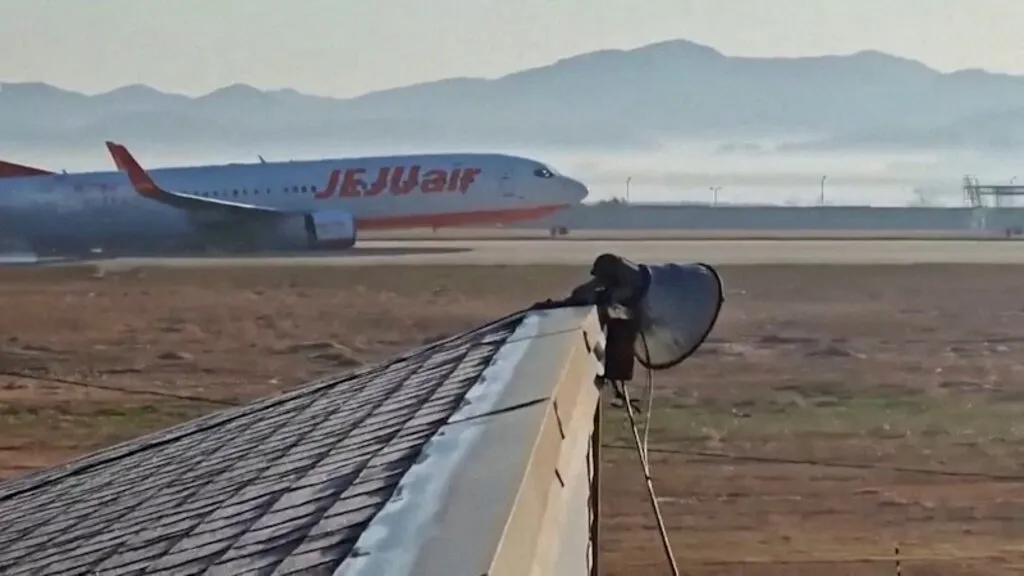On Sunday morning, South Korea experienced one of its deadliest aviation disasters, a plane crash. A Jeju Air flight returning from Bangkok crashed during landing at Muan International Airport, claiming the lives of 179 passengers and crew. The incident has sparked investigations into potential causes, including bad weather and a possible bird strike.
What Happened During the South Korea Plane Crash?
The tragic crash involved Jeju Air flight 7C2216, a Boeing 737-800 aircraft. At around 08:54 local time, air traffic control at Muan International Airport cleared the plane for landing. Shortly after, a warning about bird activity in the area was issued.
Timeline of Events:
- At 08:59, the pilot reported a bird strike, declared “Mayday,” and requested an alternative landing approach.
- At 09:02, the aircraft made contact with the runway, skidding down its length before overshooting and colliding with a barrier.
- The plane burst into flames, with emergency services arriving within minutes to contain the fire.
Witnesses reported hearing a “loud bang” followed by multiple explosions. Videos from the scene show thick smoke billowing into the sky as fire crews worked to rescue survivors.
Could a Bird Strike Be the Cause? – South Korea Plane Crash
@cakapcakapsumut Pesawat JEJU air mengalami kecelakaan di bandara internasional muan korsel , minggu pagi (29/12) #jejuair #kecelakaan #pesawat #airport #koreaselatan ♬ suara asli – 𝟑𝟎𝟑 𝐌𝐢𝐧𝐞.
Authorities are investigating whether a bird strike, combined with bad weather, contributed to the crash. The flight’s voice and data recorders have been recovered, though initial findings suggest multiple factors could be involved.
Key Insights from Experts:
- Bird Strikes in Aviation: While bird strikes are common, they rarely cause catastrophic failures. Aviation expert Geoffrey Thomas told the BBC that “typically, bird strikes don’t result in the loss of an airplane by themselves.”
- Maintenance and Experience: Jeju Air reported no prior maintenance issues with the aircraft, and the pilot had over 6,800 hours of flight experience.
- Unusual Circumstances: Some experts suggest that additional mechanical or environmental factors, such as landing gear malfunction, may have played a role.
While the exact cause remains unclear, investigators are working to analyze the damaged black boxes. Decoding these devices could take up to a month.
(Source: BBC News)
Who Were the Victims of the plane crash?
The flight carried 175 passengers and six crew members. Tragically, only two crew members survived. Most passengers were South Korean nationals, many of whom were returning from a Christmas holiday in Thailand.
Details About the Victims:
- Death Toll: 179 lives were lost, making this the deadliest aviation accident on South Korean soil.
- Children Among Victims: Five of the deceased were children under the age of 10, the youngest being a three-year-old boy.
- Identification Efforts: Authorities are using saliva samples and fingerprints to identify the bodies. So far, 141 victims have been identified.
One survivor, a male crew member, is reportedly in stable condition and communicating with investigators.
What Happens Next? – South Korea Plane Crash
South Korea’s acting president, Choi Sang-mok, has ordered an emergency safety review of the nation’s airline operations. Muan has been declared a special disaster zone, granting additional government support to victims’ families and local authorities.
Key Measures in Response:
- Flight Cancellations: All operations at Muan International Airport have been suspended.
- National Mourning Period: A seven-day mourning period has been declared, with New Year celebrations likely scaled down.
- Boeing’s Role: Boeing has stated that it is working closely with Jeju Air and South Korean authorities to support the investigation.
Could This Have Been Prevented?
Aviation safety experts stress that Jeju Air has maintained an excellent safety record since its inception in 2005. However, this crash raises questions about potential gaps in bird strike prevention, airport infrastructure, and emergency response systems.
Lessons from the Crash:
- Improved Detection Systems: Airports could benefit from more advanced bird detection and deterrence technologies.
- Emergency Preparedness: Enhanced training for pilots and ground staff could mitigate risks during critical flight phases.
- Aircraft Maintenance and Design: Further analysis of the Boeing 737-800 model may identify improvements to withstand environmental factors.
Mourning and Moving Forward
The South Korea plane crash is a stark reminder of the challenges in ensuring aviation safety. While the causes remain under investigation, the tragedy has united the nation in grief. As authorities work tirelessly to uncover the truth, the global aviation industry will undoubtedly learn from this heartbreaking incident.

